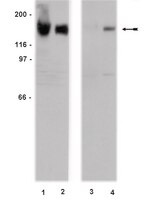Genetic interaction implicates iRhom2 in the regulation of EGF receptor signalling in mice.
Siggs, OM; Grieve, A; Xu, H; Bambrough, P; Christova, Y; Freeman, M
Biology open
3
1151-7
2014
Show Abstract
iRhoms are closely related to rhomboid intramembrane proteases but lack catalytic activity. In mammals iRhoms are known to regulate the trafficking of TACE, the protease that cleaves the membrane bound inflammatory cytokine TNF. We have mapped a spontaneously occurring mouse mutation with a loss of hair phenotype, curly bare (cub), to the Rhbdf2 locus, which encodes the iRhom2 protein. The cub deletion removes the first 268 amino acids of the iRhom2 protein but is not a loss of function. We have also identified a previously reported suppressor of cub, called Mcub (modifier of curly bare), and find it to be a loss of function allele of the amphiregulin gene (Areg). Amphiregulin is an activating ligand of the epidermal growth factor receptor (EGFR) that, like TNF, is released by TACE. Our results therefore imply a regulatory link between iRhoms and EGFR signalling in mammals. We have tested the model that the cub mutation leads to iRhom2 hyperactivity and consequently excess TACE processing of amphiregulin and elevated EGFR signalling. Our results do not support this hypothesis: we find that, compared to wild-type cells, cub mutant embryonic fibroblasts release less amphiregulin, and that the cub mutant form of iRhom2 is less able than wild type to bind to TACE and promote its maturation. | | 25395669
 |
Influence of RT-qPCR primer position on EGFR interference efficacy in lung cancer cells.
Chen, G; Kronenberger, P; Teugels, E; De Grève, J
Biological procedures online
13
1
2011
Show Abstract
Real-time quantitative RT-PCR (RT-qPCR) is a "gold" standard for measuring steady state mRNA levels in RNA interference assays. The knockdown of the epidermal growth factor receptor (EGFR) gene with eight individual EGFR small interfering RNAs (siRNAs) was estimated by RT-qPCR using three different RT-qPCR primer sets.Our results indicate that accurate measurement of siRNA efficacy by RT-qPCR requires careful attention for the selection of the primers used to amplify the target EGFR mRNA.We conclude that when assessing siRNA efficacy with RT-qPCR, more than one primer set targeting different regions of the mRNA should be evaluated and at least one of these primer sets should amplify a region encompassing the siRNA recognition sequence. Full Text Article | Western Blotting | 21369532
 |
Multiple autophosphorylation sites of the epidermal growth factor receptor are essential for receptor kinase activity and internalization. Contrasting significance of tyrosine 992 in the native and truncated receptors.
Sorkin, A, et al.
J. Biol. Chem., 267: 8672-8 (1992)
1992
Show Abstract
The role of epidermal growth factor (EGF) receptor autophosphorylation sites in the regulation of receptor functions has been studied using cells transfected with mutant EGF receptors. Simultaneous point mutation of 4 tyrosines (Y1068, Y1086, Y1148, Y1173) to phenylalanine, as well as removal of these sites by truncation of the carboxyl-terminal 123 amino acid residues, resulted in reduced receptor phosphorylation of an in vivo specific substrate phospholipase C-gamma 1 to less than 50% compared to the wild-type receptor. The internalization rate constant Ke was also significantly lower in these mutants (0.15/min) compared to cells transfected with wild-type receptor (0.27/min). Additional mutation of tyrosine 992 to phenylalanine in the truncated receptor mutant (Dc-123F) further decreased the receptor internalization rate to a minimal level (ke = 0.07-0.10/min), equivalent to the ke measured for cells expressing kinase-negative receptor (A721). Moreover, tyrosine kinase activity of the Dc-123F receptor toward phospholipase C-gamma 1, compared to wild-type receptor, was reduced by 90%. Taken together, these results show that EGF receptor lacking five autophosphorylation sites functions similar to a kinase-negative receptor. Mutation of tyrosine residue Y992 alone in the context of full length EGF receptor, however, did not affect receptor internalization or kinase activity toward phospholipase C-gamma 1. These data indicate that tyrosine 992 is critical for substrate phosphorylation and internalization only in the context of the truncated receptor, and that minor autophosphorylation sites, such as Y992, may act as compensatory regulatory sties in the absence of the major EGF receptor autophosphorylation sites. | | 1314835
 |





















